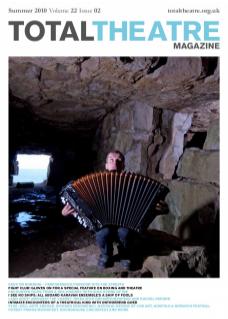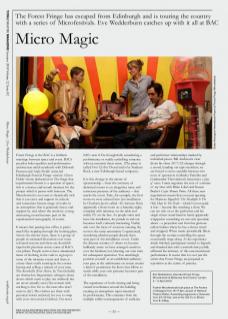Forest Fringe at the BAC is a brilliant marriage between space and event. BAC’s peculiar boho qualities and performative architecture meld seamlessly with Deborah Pearson and Andy Fields’ artist-led Edinburgh Festival Fringe venture. Given Fields’ recent declaration in The Stage that ‘experimental theatre is a question of space’, this is a money-and-mouth moment for the project which it passes with honours. The Microfestival is an event so theatrically rich that it can carry and support its eclectic and sometimes bizarre range of works in an atmosphere that is genuinely buzzy and supportive, and where the attentive, young, interesting crowd become part of the experimental scenography of events.
It means that passing box office is pretty much like stepping through the looking glass. Across the chaotic foyer, there is a group of people in animated discussion over some coloured crayons and there are showbills taped with precision across some of BAC’s vast pillars. People seem to have abandoned items of clothing in the rush to sign up to some of the intimate events and there is a time-share outfit running in the corner: buying and selling a minute of your time. The showbills (Four Posters, by Tim Etchells) are themselves fragmentary whispers about shows which seem to play out endlessly but are never actually seen (‘the women with nothing to live for vs. the men who don’t want to die’). The clothes are there with personal stories enclosed, for you to swap with your own (stories/clothes). I’m never 100% sure if I’m thoughtfully considering a performance or rudely eyeballing someone with an eccentric dress sense. (The piece is called First Up Best Dressed and is by Stadium Rock, a new Edinburgh-based company.)
It is this change in the nature of spectatorship – from the certainty of darkened rooms to an altogether more self-conscious presence of the audience – that marks the event. Take, for example, the first room we were ushered into (an installation by Charlotte Jarvis called All American Hero): apparently a front-room on a Saturday night, complete with takeaway on the table and reality TV on the box. As people enter and leave the installation, the parade in and out becomes itself curiously interesting. Visibly writ over the faces of everyone entering the room is the same uncertainty I experienced, wondering whether people already there were part of the installation or not. Under the discreet scrutiny of others we become brilliantly aware we have arranged ourselves over the furniture/set, blurring our own roles for subsequent spectators. You unwittingly position yourself as an established audience; your gaze at the unfortunate on screen creates a kind of permission for those that follow to watch while your own presence becomes part of the installation.
The experience of both viewing and being viewed reverberates around the building creating an atmosphere super-saturated by performance. This emanates from the multiple subtle rearrangements of audience and performer relationships marked by individual pieces. Bill Aitchison’s vicar (from his show 24/7/52) charges through a crowd, handing out tape-recorders; we are forced to move carefully between two rows of spectators in Mischa Twitchin and Gudmundur Thorvaldson’s Interjections: a play of voices; I must negotiate the cost of a minute of my time with Brian Lobel and Seasun Butler’s Carpe Minuta Prima. All these new negotiations meant that even just queuing for Mamoru Iriguchi’s This Headlight Is The Only Hope In The Dark – which I never made it into – became like watching a show. We can see side on as the performer and his single viewer stand hand in hand, apparently wrapped in something we can only speculate about – a projection cast from his glorious yellow helmet where he has a device wired and strapped. When music sporadically filters through the woman controlling the queue occasionally sings along. As the experience inside finished, participants turned to Iriguchi and thanked him with a warmth that joyfully affirmed the intimacy of this unconventional performance. It seems that it is not just the artists that Forest Fringe are prepared to reposition at the centre of practice.
Eve Wedderburn attended Forest Fringe Microfestival at Battersea Arts Centre, London 2 – 3 April 2010. Further Microfestivals took place at The Arches in Glasgow from 16-17 Apr; as part of National Theatre Wales’ Assembly programme in Swansea from 24–25 Apr; and at the Old Vic in Bristol from 8–9 May.

